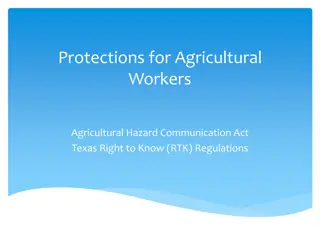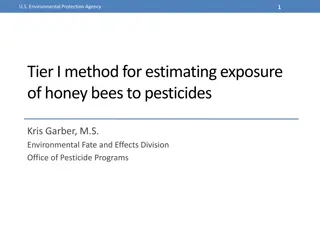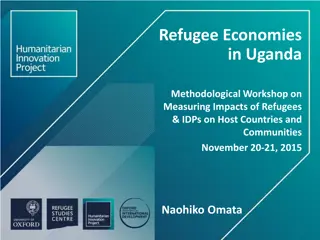Pesticide Exposure Assessment in Farmers from Malaysia, Uganda, and the United Kingdom
This study evaluates the impact of pesticide exposure on farmers' health in Malaysia, Uganda, and the UK using urinary biomarker concentrations. Multiple cohorts are analyzed to assess associations between exposure-modifying factors and urine metabolite measurements. The IMPRESS project focuses on improving exposure assessment methodologies for epidemiological studies on pesticides, with data collected pre- and post-activity along with relevant biomarkers.
Download Presentation

Please find below an Image/Link to download the presentation.
The content on the website is provided AS IS for your information and personal use only. It may not be sold, licensed, or shared on other websites without obtaining consent from the author.If you encounter any issues during the download, it is possible that the publisher has removed the file from their server.
You are allowed to download the files provided on this website for personal or commercial use, subject to the condition that they are used lawfully. All files are the property of their respective owners.
The content on the website is provided AS IS for your information and personal use only. It may not be sold, licensed, or shared on other websites without obtaining consent from the author.
E N D
Presentation Transcript
Pesticide exposure assessment in farmers from Malaysia, Uganda, and the United Kingdom: an analysis of urinary biomarker concentrations Will Mueller ISEE 2022 19 September Athens, Greece Related image
Background 4M tonnes of active ingredients applied globally each year1 Occupational exposure to pesticides linked to poorer health: cancers2, neurological effects3, acute poisoning4 5x more studies use indirect (e.g. self-reported) vs direct (e.g. biomarkers) exposure assessment methods5 Both may lead to misclassification/bias in epi studies Aim: To evaluate associations between different exposure-modifying factors and urine metabolite measurements across multiple cohorts 1FAOSTAT 2020; 2Alavanja & Bonner 2012; 3Fuhrimann et al 2021; 4Solomon et al 2007; 5Ohlander et al 2020 ISEE 2022
IMPRESS study: Cohorts Improving Exposure Assessment Methodologies for Epidemiological Studies on Pesticides (IMPRESS) project1 (www.impress-project.org) Prospective Investigation of Pesticide Applicators' Health (PIPAH) study 1. Prospective cohort (>5700 users) of pesticide users in professional registers in the UK Aim: monitor long-term health Pesticide Use in Tropical Settings Project (PESTROP) 2. Smallholder farmers (< 2 ha) in rural areas of Wakiso District, Uganda Aim: investigate environmental, health and regulatory dimensions of pesticide use in conventional and organic agriculture in LMICs Malaysian farm workers 3. Male farmers from 3 districts in Sabah registered on the Sabah Agricultural database Aim: assess organophosphate exposure and semen quality, acute ill-health 1Jones et al 2020 ISEE 2022
IMPRESS study: Data collection & biomarkers Pre- and post-activity (handling, spraying, re-entry) urine samples Diaries capturing duration, application methods, active ingredients (AIs) used, hygiene behaviours, and use of personal protective equipment (PPE) Selection of urinary biomarkers based on number of AI users and existence of validated methods Half-life range (hours) Limit of Quant. ( g/L) Biomarker Active ingredient Type 3PBA Pyrethroids Insecticide 5.7-8.7 0.5 DCVA Cypermethrin, cyfluthrin, permethrin Insecticide 6.4-38.5 0.5 CFVA Lambda-cyhalothrin, bifenthrin Insecticide 4.2-11.2 0.6 DBVA Deltamethrin Insecticide 3.6 0.7 ETU Mancozeb Fungicide 20-100 0.5 Glyphosate Glyphosate Herbicide 5.5-9.0 0.5 TCPyr Chlorpyrifos Insecticide 6-50 1.0 ISEE 2022
Statistical analysis Models (separately by cohort and AI): Multi-level censored (Tobit) regression, random intercept for participant (and visit) Dependent variable Log of pre- and post-activity concentration Exposure Modifying Factors: Use of AI that day Total duration of specific AI use (mixing & spraying) PPE for mixing/spraying (low/med/high based on protection of body parts) Any hygiene behaviours (e.g., change gloves, wash hands) Type of application (boom/manual) Activity (spraying, re-entry, mixing) Also adjusted for: Sampling time, Age, Sex, Education/Literacy, Creatinine concentrations Sensitivity analyses (e.g., prior AI use, specific product, time since AI use) ISEE 2022
Results Age (years) Mean (SD) Sex (male) (%) Study Urine samples (n) Study participants (n) 57 (8.1) 100 UK 106 212 46 (11.6) 76 Uganda 85 384 46 (15.6) 100 Malaysia 81 162 Study 3PBA DCVA CFVA DBVA ETU Glyphosate TCPyr 64 64 64 64 0 212 64 UK 216 216 216 216 384 384 216 Uganda 147 147 147 147 64 40 147 Malaysia ISEE 2022
Results UK Malaysia Uganda Active ingredients Biomarker % use % detected % use % detected % use % detected 3PBA 16 45 47 93 31 60 Pyrethroids Cypermethrin, cyfluthrin, permethrin DCVA 4 19 35 77 31 68 Lambda-cyhalothrin, bifenthrin CFVA 8 2 5 37 4 5 DBVA 5 14 7 14 0 3 Deltamethrin ETU 2 0 12 11 33 84 Mancozeb Glyphosate 88 58 0 27 18 42 Glyphosate TCPyr 1 67 30 100 2 87 Chlorpyrifos Selected 3PBA and glyphosate for analysis: % AI use and biomarker detection across cohorts ISEE 2022
Results Pyrethroid & Glyphosate Users 3PBA (Pyrethroids) UK Uganda Malaysia 2.2 0.5 0.5 2.2 0.9 0.8 Glyphosate 1.7 0.5 0.8 7.6 No users Higher post-activity urinary biomarker concentrations with glyphosate
Fold-change in 3PBA (Pyrethroids) concentrations Malaysia UK Uganda Lower PPE & longer activity duration were associated with higher concentrations Additional analysis: UK - Lower concentrations with changing gloves Malaysia - Higher concentrations with cypermethrin use ISEE 2022
Fold-change in Glyphosate concentrations Uganda UK Lower PPE, education and longer activity duration were associated with higher concentrations Additional analysis: UK - Lower concentrations with changing mask ISEE 2022 Uganda High concentrations with Glyphosate use in previous week (not year)
Interpretation Urinary biomarker concentrations are higher in applicators in Malaysia and Uganda than UK Greater increases in urinary biomarkers for glyphosate vs pyrethroid use May be due to exposure routes (e.g. delayed dermal uptake), metabolism Duration of activity was found to be important across cohort and AI (i.e. not just AI use) Lower education/illiteracy was associated with higher concentrations for glyphosate Indication of lower exposure with PPE, but only in the UK Lower levels of PPE worn in tropical, LMIC settings No exposure factor was identified consistently across all analyses Biomarkers can objectively indicate exposure, but may be complicated by (other) exposure routes & metabolism ISEE 2022
Thank you for listening! will.mueller@iom-world.org www.impress-project.org Acknowledgements Co-authors: Kate Jones, Anne-Helen Harding, Andy Povey, Martie van Tongeren, Ioannis Basinas, Hans Kromhout, Samuel Fuhrimann, Zulkhairul Naim Bin Sidek Ahmad, Aggrey Atuhaire, Karen Galea Thanks to our Scientific Advisory Board (SAB): Mark Montforts (Chair), RIVM (The Netherlands) Len Levy, Cranfield University (UK) Silvia Fustinoni, University of Milan (Italy) Aaron Blair, National Cancer Institute (USA) (now retired from SAB) To all our study participants Project funded by CropLife Europe ISEE 2022























